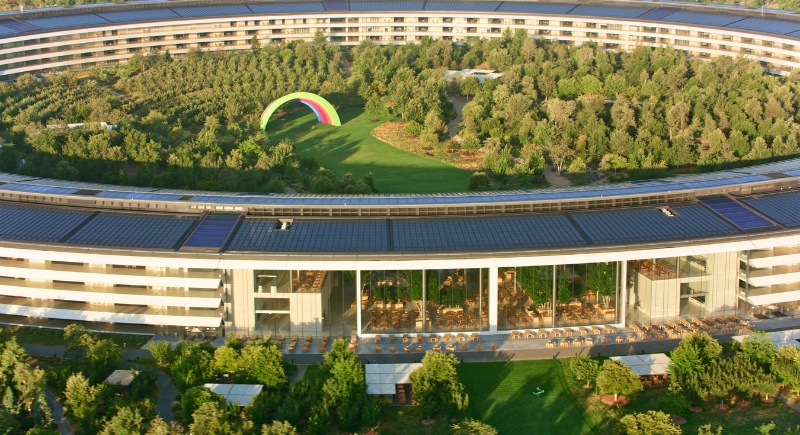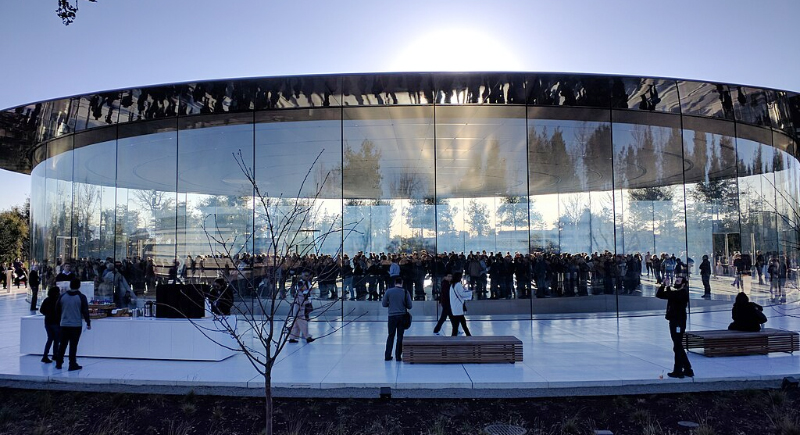Apple’s HQ Is a Giant Fortress Designed to Keep People Out
You can’t really see much of Apple’s headquarters unless you’re inside it. It appears to be a glass circle rising from the lush greenery of Cupertino. What’s really interesting is how intentionally it’s built to keep things contained.
Apple Park has been called many things—a spaceship, a symbol of perfection, even a monument to secrecy. It cost billions to create and stretches nearly a mile around. For all its beauty and efficiency, it is almost impossible to access. What goes on inside those glass walls stays there, and the design choice might reveal more about the company than any keynote ever could.
The Ring That Rules Them All

Image via iStockphoto/simonkr
At the heart of Apple Park stands The Ring, a four-story circular structure designed to hold over 12,000 employees. It stretches nearly a mile in circumference and cost about $5 billion to build. The building’s 800 curved glass panels, each forty-five feet tall, make it one of the largest glass constructions ever attempted. It’s sleek and deliberately minimal, just like Apple’s products.
The campus spans 175 acres, surrounded by 9,000 trees and featuring walking trails. With 80 percent of the grounds covered in greenery, it feels more like a massive park with an office in the center than a typical corporate campus.
Steve Jobs’ Last Masterpiece
In 2011, just months before his passing, Steve Jobs presented Apple Park’s vision to the Cupertino City Council. He wanted a space that blended technology with nature to avoid the typical sterile corporate feel.
Architect Norman Foster brought that vision to life by creating a structure that looks impossibly modern yet grounded in its surroundings. The hills that conceal the campus’s scale were sculpted using soil excavated from the site itself.
Jobs personally approved details as small as the staircases and the placement of trees. His idea was to design a place where people could meet naturally and collaborate easily. The irony is that while the building was intended to unite, it became one of the most exclusive offices in Silicon Valley.
Apple Park is both elegant and built to withstand the test of time. Beneath the surface, 692 steel saucers form the base isolation system that allows the building to move up to four feet in any direction during an earthquake. This setup reduces tremors by around 80 percent.
The concept came from Japan, a country Jobs often looked to for engineering inspiration. The facility also runs entirely on renewable energy, primarily generated by rooftop solar panels. The sustainable complex that can continue to function even if much of the surrounding region loses power.
The Perks And The Paradox

Image via Wikimedia Commons/Justin Ormont
Employees describe Apple Park’s interior as both stunning and controlled. The open layout encourages collaboration, yet access across departments remains limited. Apple’s secrecy culture means teams often work side by side without knowing what others are doing. Even senior employees rarely see a finished product until it’s officially unveiled.
Despite the transparency of glass walls and open spaces, access remains tightly restricted. Movement is tracked through security badges.
Life inside Apple Park strikes a balance between comfort and discipline. The main cafeteria, known as The Restaurant, features four-story sliding glass doors that open onto the courtyard. Meals are subsidized, too.
The campus includes a wellness center with a yoga studio, basketball courts, and a juice bar. Employees enjoy product discounts, fertility benefits, and even fresh fruit from the on-site trees. Still, Apple’s push to bring staff back to the office after the pandemic was met with resistance. Many argued they were more productive working remotely than commuting to what some called a “$5 billion showcase.”
For Everyone Else
The public’s access ends at the Apple Park Visitor Center across the street. It features a café, a store with exclusive merchandise, and an augmented reality model of the headquarters. The rooftop deck offers a clear view of The Ring through the trees, which gives visitors a glimpse of Apple’s hidden world.
Beyond that point, the campus stays off-limits. Inside those glass walls sits one of the most advanced workplaces ever built.